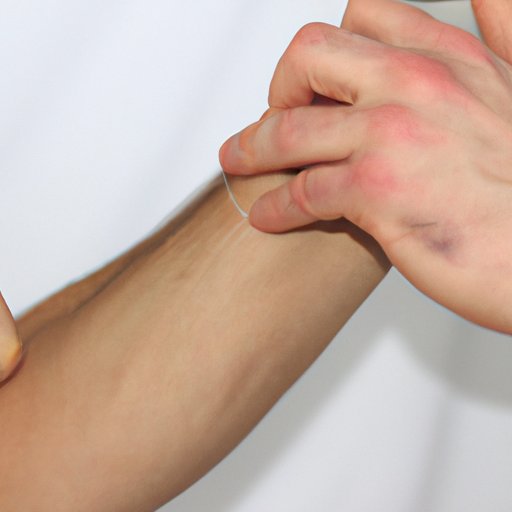
I. Introduction
Tennis elbow, also known as lateral epicondylitis, is a common condition that affects the elbow’s outer region. It is caused by repetitive muscle and tendon use, and it can occur in sports, manual labor, or everyday activities such as typing and cooking. The symptoms typically include pain, stiffness, weakness, and swelling. While tennis elbow might seem like a minor issue, it can lead to chronic pain if left untreated. Therefore, seeking solutions and implementing effective strategies for healing tennis elbow is crucial for anyone experiencing this issue.
II. Research-based tips for healing tennis elbow
The latest research and studies indicate various methods to manage the pain and speed up the healing process of tennis elbow. Some of the tips include:
- Rest and ice: avoiding activities that aggravate the elbow, and applying ice packs for 10-15 minutes several times a day, can help reduce inflammation and pain.
- Stretching and strengthening exercises: specific exercises that target the forearm muscles, such as wrist extensions and wrist curls, can improve the elbow’s flexibility and strength, and alleviate the symptoms of tennis elbow.
- Massage therapy: hands-on techniques that involve manipulating the muscles and soft tissues around the affected area can increase blood flow, reduce stiffness, and promote healing.
- Acupuncture: a traditional Chinese medicine therapy that involves inserting thin needles into specific points on the skin can help alleviate pain and inflammation by stimulating the body’s natural healing processes.
- Extracorporeal shockwave therapy: a non-invasive treatment that uses high-energy sound waves to stimulate healing and tissue regeneration can be effective for chronic tennis elbow cases.
III. Natural remedies for tennis elbow
While medical treatments can be effective, some people prefer to use natural remedies to manage their tennis elbow symptoms. Here are some of the most popular natural remedies:
- Essential oils: oils such as peppermint, eucalyptus, and lavender have anti-inflammatory and pain-relieving properties that can help reduce pain and swelling. They can be applied topically or used in a diffuser for aromatherapy benefits.
- Herbal remedies: herbs such as ginger, turmeric, and white willow bark have been used for centuries to treat pain and inflammation. They are available in supplements, capsules, or teas.
- Vitamins and supplements: some supplements such as omega-3 fatty acids, vitamin C, and magnesium, have shown to reduce inflammation and promote healing for tennis elbow.
IV. Exercises and stretches for tennis elbow
Exercises and stretches can not only help reduce pain and inflammation but also prevent further injuries and improve overall strength and flexibility. Here are some beneficial exercises and stretches to try:
- Wrist extensor stretch: extend one arm with your palm facing down, use the other hand to pull its fingers toward your body. Hold for 15-30 seconds and repeat 2-3 times for each arm.
- Wrist curls: sit with your forearms resting on a table, palms facing up, and grasp a light weight, such as a can of soup or a bottle of water. Slowly curl your wrist and then lower it, repeating for 15-20 repetitions for each arm.
- Reverse wrist curls: sit with your forearms on the table, palms facing down, and lift the weight with your wrist, then lower it. Repeat for 15-20 repetitions for each arm.
- Finger squeezes: hold a tennis ball or a grip strengthener in your hand and squeeze it for 5-10 seconds, then release. Repeat for several times for each hand.
V. Lifestyle changes to prevent tennis elbow
Prevention is key to avoid tennis elbow from happening, or from getting worse. Making some lifestyle changes can be helpful, such as:
- Adjusting workstations: make sure your computer, desk, and chair are at an optimal height that doesn’t strain your arms and shoulders. Use ergonomic accessories, such as a wrist pad or a split keyboard.
- Playing techniques: in case of playing sports that might cause tennis elbow, make sure to use proper techniques, grips, and equipment to avoid overusing the arm muscles and tendons.
- Warming-up: before starting any physical activity or exercise, make sure to stretch and warm-up properly to reduce the risk of injuries.
VI. Medical treatments for tennis elbow
When natural remedies and lifestyle changes are insufficient for treating tennis elbow, several medical treatments are available. These include:
- Physiotherapy: a therapist can show you specific exercises, stretches, and massage techniques that target the affected area and help reduce pain and inflammation.
- Corticosteroid injections: a physician can inject corticosteroid medication into the affected area to reduce swelling and stiffness.
- Bracing or splinting: wearing a brace or a splint can help relieve stress on the affected area and allow it to rest and heal.
VII. Mental health considerations for coping with tennis elbow
Coping with tennis elbow can be challenging, not only physically but also mentally. Chronic pain can lead to stress, frustration, anxiety, and depression. Therefore, it is essential to take care of your emotional and mental well-being. Here are a few tips to manage:
- Practice relaxation techniques: such as deep breathing, meditation, yoga, or tai chi, to reduce stress and promote relaxation.
- Reach out for support: talk to your friends, family, or a therapist about your struggles and concerns. You don’t have to face tennis elbow alone.
- Set realistic expectations: healing from tennis elbow might take time and patience. Don’t push yourself too hard, and be gentle and understanding with yourself.
VIII. Conclusion
Tennis elbow is a common, but treatable condition that affects people of all ages and lifestyles. By following these effective strategies, you can manage the pain, accelerate healing, and prevent it from happening or reoccurring. Whether you prefer natural remedies, exercises, medical treatments, or a combination of them all, it’s essential to seek the help you need and take good care of yourself both physically and mentally.




